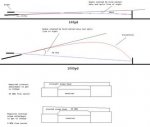I new here and this is my first post, so please be nice.
I've googled, and searched existing threads and I'm still confused.
Here is my setup:
Rifle: Remington 700 5R 24" .308 win
Optics: Leupold VX-R Patrol 3-9x
Ammo: Federal Gold Medal Match 175gr Sierra MatchKing (GM308M2)
Mount: 20 MOA picatinny base with 30mm standard rings (.823").
I intend to use this setup for target / fun shooting 100 yards out to maybe 500 yards max. I also intend to hunt deer with different ammo of course, hunting round will be Federal Fusion .308 180gr since the ballistics look like they match closely with the Match ammo I have.
Finally my question:
If I sight in at 100 yards or maybe even 200 yards. How will my 20 MOA base impact my scope MOA adjustments when I want to move my shot out from 100 yards to 500 yards?
The fancy hornady calc seem to tell me that I need to come up 9.9 MOA if I sighted in at 200 yards, but since my scope base is +20 MOA does this mean I'm actually going to be shooting too high and I'll need to drop 10.1 MOA?
This whole angle of the scope base has me pretty confused and I can't seem to find a ballistic clac that takes that into consideration, I wish I wound have just got the flat base for my 100-500 yard gun until I became more of an expert in this stuff.
Any advice, help, or links to a better ballistic clac would be great.
I've googled, and searched existing threads and I'm still confused.
Here is my setup:
Rifle: Remington 700 5R 24" .308 win
Optics: Leupold VX-R Patrol 3-9x
Ammo: Federal Gold Medal Match 175gr Sierra MatchKing (GM308M2)
Mount: 20 MOA picatinny base with 30mm standard rings (.823").
I intend to use this setup for target / fun shooting 100 yards out to maybe 500 yards max. I also intend to hunt deer with different ammo of course, hunting round will be Federal Fusion .308 180gr since the ballistics look like they match closely with the Match ammo I have.
Finally my question:
If I sight in at 100 yards or maybe even 200 yards. How will my 20 MOA base impact my scope MOA adjustments when I want to move my shot out from 100 yards to 500 yards?
The fancy hornady calc seem to tell me that I need to come up 9.9 MOA if I sighted in at 200 yards, but since my scope base is +20 MOA does this mean I'm actually going to be shooting too high and I'll need to drop 10.1 MOA?
This whole angle of the scope base has me pretty confused and I can't seem to find a ballistic clac that takes that into consideration, I wish I wound have just got the flat base for my 100-500 yard gun until I became more of an expert in this stuff.
Any advice, help, or links to a better ballistic clac would be great.


